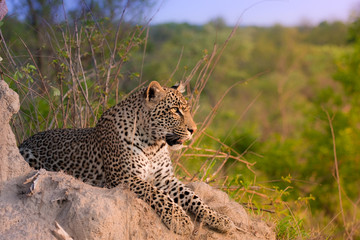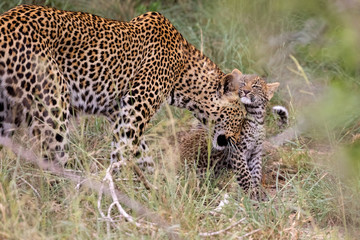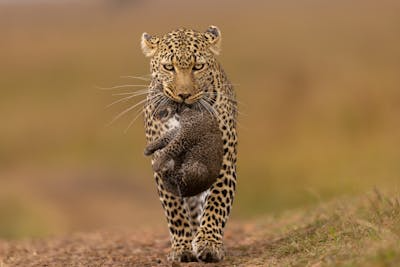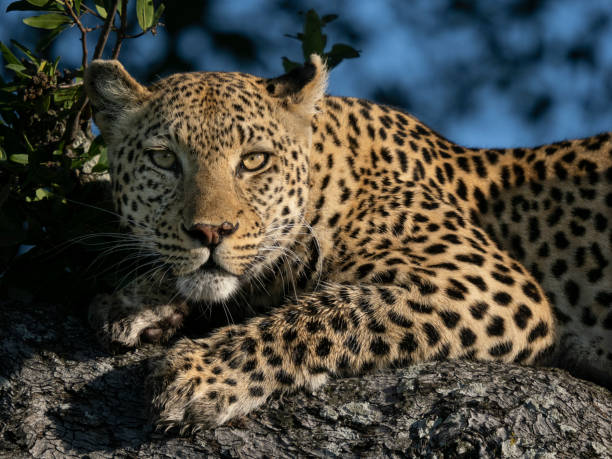Table of Contents
Scientific Classification
| Kingdom | Animalia |
| Phylum | Chordata |
| Class | Mammalia |
| Order | Carnivora |
| Family | Felidae |
| Genus | Panthera |
| Species | Panthera pardus |
| Scientific Name | Panthera pardus pardus |
Description
The African Leopard (Panthera pardus pardus) is a large, solitary cat known for its strength, agility, and adaptability. This elusive predator is easily recognized by its striking golden-yellow coat adorned with black rosettes, making it one of the most prevalent big cats across Africa.
Adult males typically weigh between 60 and 90 kg (132 to 198 lbs), while females are smaller, averaging 35 to 60 kg (77 to 132 lbs). They stand about 50 to 80 cm (20 to 31 inches) tall at the shoulder, with a body length that can extend up to 2 meters (6.5 feet), excluding the tail.
Leopards are celebrated for their stealth, power, and remarkable ability to adapt, which enables them to thrive in diverse environments while evading threats and predators.

Distribution
African leopards boast one of the most extensive ranges among wild cats. They inhabit various environments across sub-Saharan Africa, including dense forests, savannas, semi-arid regions, and mountainous areas. Key countries where leopards are frequently spotted include:
South Africa
Kenya
Tanzania
Botswana
Namibia
Nigeria
Gabon
While their distribution is broad, habitat fragmentation has resulted in population declines in certain regions.
Habitat
The African Leopard is very adaptable. It can thrive in many environments, such as:
- Rainforests – Thick vegetation offers excellent cover for stalking prey.
- Savannas – Open grasslands interspersed with trees allow for ambush hunting.
- Mountains and Hills – Rocky outcrops provide vantage points and hiding spots.
- Semi-Arid Regions – Leopards can live in dry areas if there’s enough food and water.
- Urban Fringes – Some leopards now live near human settlements. This increases the chance of conflict.
Their skill to blend in makes them one of the wild’s most elusive predators.
Diet
Leopards are opportunistic carnivores with a highly varied diet. Their prey includes:
- Medium-sized ungulates – Impalas, bushbucks, and duikers.
- Small mammals – Hares, rodents, and monkeys.
- Birds – Guinea fowl and francolins.
- Reptiles – Occasionally consuming lizards and snakes.
- Livestock – In areas where natural prey is scarce, leopards may target goats and sheep.
Leopards hunt alone, unlike lions. They use stealth and ambush tactics to catch their prey. They are known for their skill in dragging prey up trees. This keeps it safe from scavengers like hyenas and lions.
Behavior
African leopards are mostly solitary. They meet during mating season or when a mother raises her cubs. They are secretive and most active at dawn and dusk, which is called crepuscular. However, they can hunt at any time if needed.
Key Behavioral Traits:
- Territoriality – Males create big home ranges. They mark these areas with claw scratches, urine, and scent from their glands.
- Climbing Ability – They are excellent climbers and often rest in trees during the day.
- Swimming – Though they prefer dry land, leopards can swim when needed.
- Communication – They use growls, roars, and distinctive “sawing” vocalizations to communicate.
Stealth and Ambush Hunting – Their incredible patience and precision make them deadly hunters.

Lifespan
In the wild, African leopards typically have a lifespan of 12 to 15 years. However, in captivity, they can live for 20 years or more due to access to medical care and a consistent food supply. Their survival in the wild is significantly influenced by factors such as competition, food availability, and human activities.
Reproduction and Lifecycle
Leopards have a captivating reproductive cycle:
Mating Season – Leopards can mate throughout the year, although the peak seasons differ depending on the region.
Gestation Period – This lasts approximately 90 to 105 days.
Litter Size – A female typically gives birth to 2 to 3 cubs, but some litters can consist of up to 4 cubs.
Cub Rearing – Cubs are born blind and depend on their mother for nourishment and safety during their first few months.
Independence – Young leopards usually become independent between 12 to 18 months of age.
Females reach reproductive maturity at around 2 to 3 years, while males take a little longer.
Leopard cubs face a high mortality rate, often due to predation by lions, hyenas, and even adult male leopards. In some cases, male leopards may target cubs to mate with their mothers.

Predators
Although leopards are top predators, they still face threats from other animals:
- Lions – Direct competitors for food; lions may kill leopards to eliminate competition.
- Hyenas – Scavenge leopard kills and sometimes attack leopard cubs.
- Wild Dogs – Occasionally pose a threat when in large packs.
- Crocodiles – Ambush leopards at water sources.
- Humans – The greatest threat due to habitat destruction and poaching.
Adaptations
- Leopards possess a range of adaptations that enhance their skills as predators:
- Camouflage – Their spotted fur helps them blend into their surroundings, rendering them almost invisible.
- Powerful Jaw and Claws – These features enable them to capture and transport sizable prey.
- Strong Limbs – They can climb trees and jump impressive distances thanks to their muscular legs.
- Exceptional Vision – Their night vision allows them to hunt efficiently in low light.
- Silent Movement – The padding on their paws facilitates quiet stalking.
Conservation Status
The African Leopard is marked as “Vulnerable” by the IUCN. Some populations face higher risks from human threats.
Threats:
- Poaching – People hunt leopards for their skins, bones, and body parts. These are often used in traditional medicine.
- Habitat Loss – Expanding human settlements and agriculture reduce available territory.
- Retaliation Killings – Farmers may kill leopards to protect livestock.
- Illegal Wildlife Trade – The demand for leopard pelts and trophies fuels hunting.
Conservation Efforts:
- Protected Areas – National parks and reserves help sustain leopard populations.
- Anti-Poaching Measures – Increased law enforcement to curb illegal hunting.
- Community Involvement – Educating local communities on leopard conservation.
- Scientific Research – Studying leopard populations to implement better conservation strategies.
Conclusion
The African Leopard is a remarkable predator, showcasing agility, intelligence, and adaptability. However, despite their resilience, leopards are increasingly threatened by human activities. It is crucial that we maintain our conservation efforts to protect these incredible cats and ensure the preservation of Africa’s rich biodiversity for future generations.



